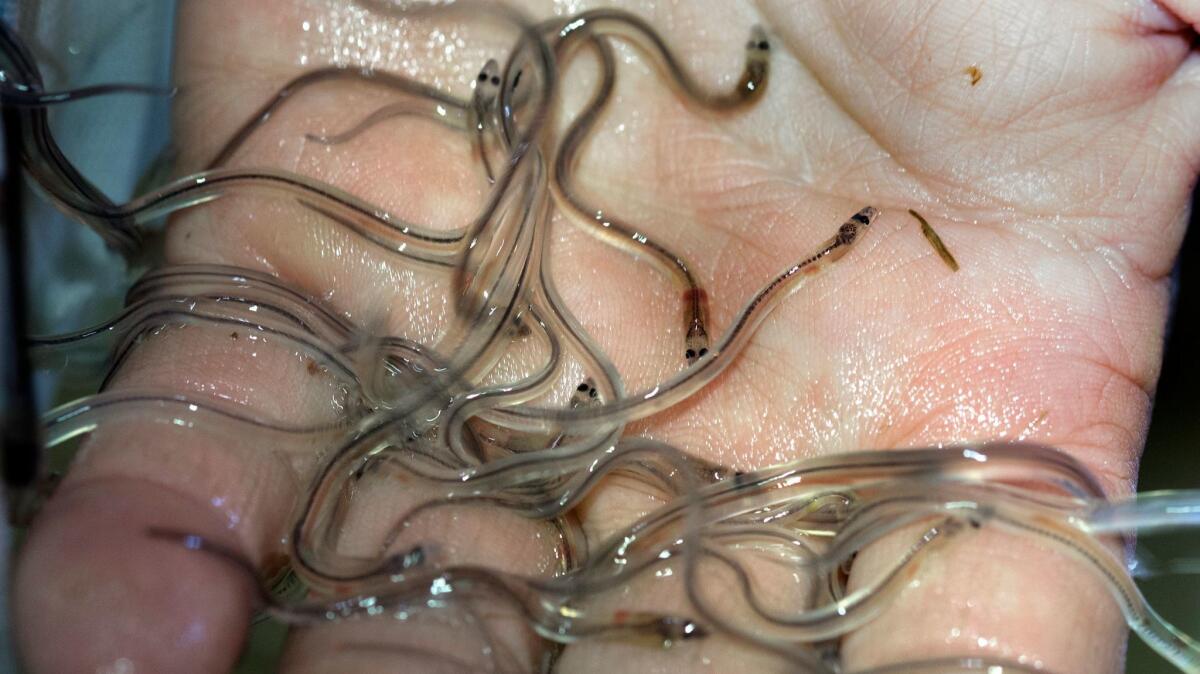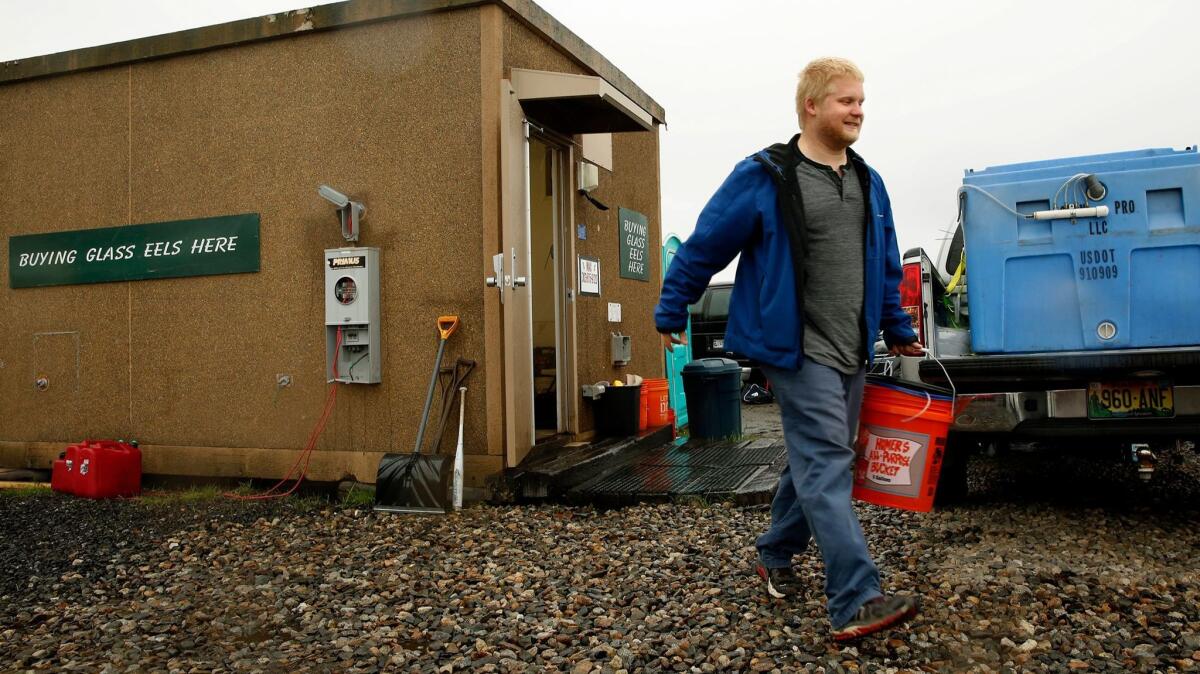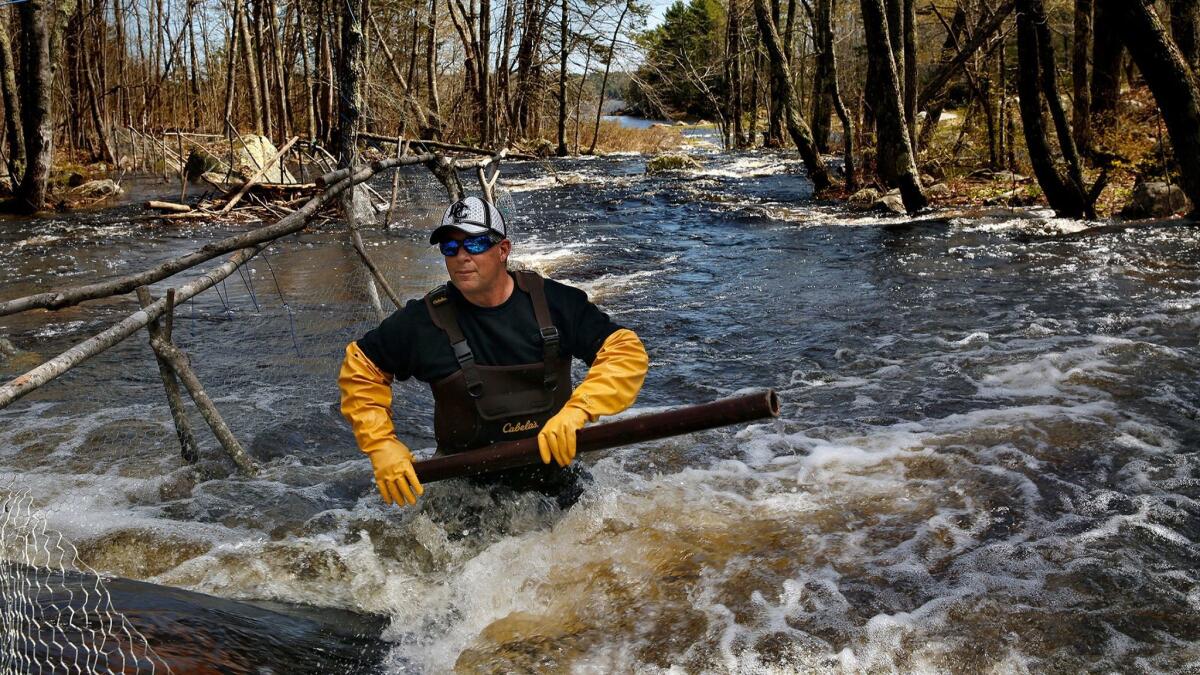Maine’s latest fishing frenzy brings in $1,200 a pound — and it’s not lobster

Maine’s fishermen have discovered that eels, long dismissed as a nuisance fish, are in such demand in Asian markets that they are more profitable than even the beloved Maine lobster.
- Share via
Reporting from Ellsworth, Maine — It is just past midnight, rain clouds stalking a full moon, and Julie Keene is out on a muddy riverbank in thigh-high rubber boots and a camouflage jacket, a headlamp strapped over her hair.
As she wrestles with an oversize fishing net, Keene tells how she went from rags to riches, and that’s not a story many fishermen tell.
Just a few years ago, the sardine factory in her hometown of Lubec had closed, and Keene was scrounging for a living digging clams and gathering periwinkles from the beach.
“We were so damn poor we were on food stamps,” Keene said.
Then came what for Maine was the equivalent of a gold rush. It was slimy, squirmy baby eels — in such demand in Asian markets that they were suddenly more profitable than even the beloved Maine lobster.
One memorable night in 2012 when the baby eel were running strong, Keene was paid $36,000 — in cash — for her catch.
“I almost threw up. I felt like I had robbed a bank. I couldn’t grasp the concept of that much money,” Keene recalled.
The eel rush allowed Keene, the daughter of a lighthouse keeper, to buy a small farm, a tractor and a truck. She even started a retirement account.

Government regulators have since stepped in to slow the fishing frenzy, but with American glass eels fetching $1,200 a pound and up, federal and state authorities have launched a wide-ranging criminal investigation to halt what has become a multimillion-dollar international smuggling industry that is threatening the survival of the much-maligned species.
Eleven people have pleaded guilty in Maine and South Carolina since last year to illegally trafficking in baby eels, and two more are awaiting trial.
“Skyrocketing prices for juvenile American eels in Asia have led to a surge in poaching and trafficking in this unique species, threatening to wipe it out in the rivers of the Northeast,” Dan Ashe, then director of the U.S. Fish and Wildlife Service, said when the case was announced in October.
Europe has had serious problems. The eel population has declined by 90% across the continent over the last 30 years, and with the fish now considered critically endangered there, exports to Asia have been banned.
In the United States, the American eel was at “very high risk” of extinction in the wild as of 2014, according to the International Union for Conservation of Nature.
U.S. officials have stopped short of declaring the American eel endangered, noting in 2015 that harvest quotas adopted after the initial eel rush “have reduced stressors on the species.”
But conservationists say there is significant cause for concern.
“Eels are in a massive crisis,” said Andrew Kerr, chairman of the Sustainable Eel Group, a British-based organization dedicated to the protection of the European eel, which is closely related to the American eel.

“It doesn’t have the panda’s beauty or the tiger’s emotional status. The only people who care about eel are those who want to enjoy eating it,” he said.
In addition to overfishing, dams are also contributing to the decline of the species, blocking eels’ paths both upriver to grow and downriver to spawn.
Only Maine and South Carolina now permit fishing of glass eels, or elvers, as the young ones are called. A total of 425 people in Maine have licenses, and the state’s total take is restricted to 9,600 pounds, less than half of what was fished in 2012. But federal authorities say there is evidence that fishermen from other states are bringing illegal catches to Maine in an attempt to skirt federal regulations.
Disputes between fishermen and environmental regulators are an eternal feature of life in Maine, as regular as the ocean tides, but the conflict over the eel is especially impassioned because the prices are so astronomical and the supply of baby eels so seemingly plentiful.
“I know fishermen are always complaining that the government is trying to take a piece of everything, but in this case, with eels, it is absolutely insane how many eels there are. Maybe trillions,” said Henry McVane, 25, whose family has been fishing in the Portland area for three centuries.

“This river is quivering with eels. So many it is like something biblical,” said Keene, 57, whose speech alternates between salty expletives and great bursts of sobbing emotion. She still fishes eel, but is allowed only 44 pounds a year, which earns her about $50,000 before expenses — nothing like what she was making before.
“We could lift our families out of poverty if only the government would let us,” she said.
Anguilla rostrata, the American eel, has an unusual migration pattern — opposite that of trout and salmon — in that it is born in deep water, the North Atlantic’s Sargasso Sea, then migrates to freshwater ponds along the East Coast, where it spends as long as 20 years before it reaches sexual maturity. The adults then return to the ocean to spawn and die, and their young migrate back to fresh water.
Elvers are unimpressive creatures that look like a cross between a translucent rice noodle and a guppy with beady little black eyes. They command high prices because they can be exported cheaply to fish farms in China, where in a few months they will grow to half a pound each, large enough to market as food. From there they are resold to Japan, where they are enjoyed grilled, with a brushing of sweet soy sauce.
“Nobody in Maine eats eel,” said Darrell Young, co-director of the Maine Elver Fishermen Assn. “I used to see them when I was out trout fishing. I was scared of them because they look like snakes.”
Until the early 1990s, there were few laws restricting the catch of baby eels.

“It was like going out and catching mosquitoes. Nobody gave a hoot,” said William Sheldon, one of the fishermen now under indictment on allegations of eel trafficking. Sheldon, 71, is revered as the father of Maine’s modern eel trade.
Fresh out of college in the 1970s, Sheldon was working for the Maine Department of Marine Resources when a letter arrived from Tokyo inquiring about the availability of baby eel in Maine. His boss asked him to investigate. He ended up writing a series of articles and a book about how to find and catch elvers.
Sheldon left his state job shortly afterward to go into business. At first he didn’t bother with elvers — the prices weren’t very high back then because too many died in transit to Asia — and he instead bought a lobster boat. After that boat capsized, leaving him broke, he turned to elvers. He and a partner would catch the first run in Florida in January, moving up the coast state by state as the weather warmed.
“We were gypsy eelers. We lived in motels,” said Sheldon. He and his partners worked quietly, fearful of attracting competitors, but as prices rose, others caught on, including Keene.
Keene remembers finding a monograph written by Sheldon in the reading room of the Portland Public Library in the 1990s. “I couldn’t check it out, so I copied it and took it home. Then I studied,” she said.
What was appealing about eels was you didn’t need to risk your life on the open seas. You didn’t even need a boat. You needed knowledge about where and when to put down your net — where the river meets the sea, on the dark spring nights when the rising tides sweep in a fresh crop of baby eel from the ocean. Eel fishing attracted aging fishermen too old to go out to sea, but too poor to retire.

As aquaculture techniques in Asia improved, fishing for elvers became more profitable. The business grew as Chinese companies took over and started importing the babies — needed because eel require the pressure of the deep sea to breed, and cannot be bred in captivity. Then in 2010, Europe banned the export of glass eels, boosting demand for American eels. The 2011 earthquake and tsunami further disrupted Japan’s own supply.
In 2012, prices soared to $2,600 a pound, and the rush was on. On Ellsworth’s Union River, one of the best locations in Maine to catch elvers, fishermen stood so close to one another on the riverbanks that they had to dip their nets in synchronization.
In one incident in 2013, state game wardens tried to seize the gear of a group of fishermen from the Passamaquoddy tribe, but were quickly surrounded by dozens of allies of the fishermen, many of them armed, and had to withdraw.
“It was a bit of a Wild West scenario. Everybody was carrying guns,” said Patrick Keliher, Maine’s state commissioner of marine resources. “People who were making $20,000 a year were suddenly making $500,000.”
Keliher said the strict quotas helped keep the industry viable. “They are lucky they have a quota at all. By strictly regulating the market, they saved the fishery.”

Fishermen no longer get paid in cash. When they sell, they present the dealer a swipe card, which records the size of their catch and prevents them from exceeding their quota.
“Every single penny they make is recorded and taxed,” said Sheldon, who despite the indictment is still running Maine Eel Trade & Aquaculture out of a warehouse a few blocks from the Union River in Ellsworth.
On a recent day, fishermen were bringing in their elvers swimming in buckets. Sheldon poured them into a net to drain the water and then carefully turned each net upside down and inside out over a metal scale, so as not to miss a single eel.
The indictment against Sheldon alleges that he bought baby eels that were illegally fished in New Jersey, Massachusetts, Virginia and North Carolina and falsified records to make it appear they were legal. He is also charged with buying illegal eels from an undercover federal agent. If convicted, he faces up to 35 years in jail.
Sheldon finds the whole case perplexing.
“I could very well end up spending the rest of my life in jail,” he said. “Even my wife says, ‘Gee, Bill, it’s only eels.’”
Twitter: @BarbaraDemick
More to Read
Sign up for Essential California
The most important California stories and recommendations in your inbox every morning.
You may occasionally receive promotional content from the Los Angeles Times.













